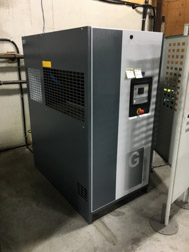 A big question when buying an air compressor is “will it be big enough?” Having a larger compressor than you currently need reduces the possibility of pressure problems due to lack of capacity, but purchasing a compressor that is too large can significantly increase your operating costs—especially if you choose a fixed speed lubricated screw compressor.
A big question when buying an air compressor is “will it be big enough?” Having a larger compressor than you currently need reduces the possibility of pressure problems due to lack of capacity, but purchasing a compressor that is too large can significantly increase your operating costs—especially if you choose a fixed speed lubricated screw compressor.
Air compressors need to be sized large enough to adequately supply peak demands; if they aren’t, the system pressure will fall during a time when you need it the most. But, typically, peak flows occur only a small fraction of the time, and the remainder of the operating hours are spent at lower flows. This is where efficiency problems occur, as a fixed speed screw compressor part loads, it becomes less and less efficient.
The reason for this inefficiency is unloaded power consumption. Most screw compressors remain running when they are unloaded, a unit running in load/unload mode will be consuming about 25% to 35% of its full load power even though no air is being produced. And as the load on the compressor gets lighter, more hours are spent in the unloaded condition. For example, a compressor at 40% load might spend 60% of its operating hours running unloaded.
This is where size matters, if the new compressor you chose is double the size that you really need, then the extra energy cost is quite significantly more. Let’s look at an example: a 50 hp (37 kW) compressor with 43 kW full load and 15 kW unloaded power consumption. A compressor of this size at an average 40% load, and running with storage capacity of 2 gallons per cfm, would consume about 32 kW when the effect of the storage receiver size is considered. But if the compressor chosen was double size—say 100 hp or 75 kW—and the storage receiver size remains the same, then the larger compressor would consume about 56 kW at the same capacity, about 80% more power than the smaller unit. At full-time operation, and 10 cents per kWh electrical costs, this would consume about $22,000 more per year in electrical costs!
Some solutions to bring the operating costs down:
- Purchase two 50 hp compressors instead of one 100 hp, a well-controlled system with two smaller compressors, for this example, would keep the power consumption at about 31 kW, yet give double the peak capacity.
- Install larger storage receiver capacity. If the original 50-hp compressor had 10 gallons of receiver capacity per cfm, its power consumption would lower to 26 kW, a reduction of 19%. For the 100-hp compressor, the power reduction would be 36%.
- Purchase a variable speed drive compressor. These compressors have very low or no unloaded power consumption. A unit of 50 hp in size at 40% load would consume slightly more than 40% of its full load power consumption. This would result in an approximate 44% reduction in power consumption for the same loading conditions. For the oversized 100 hp compressor, the savings due to variable speed drive would be about 55%, depending on the compressor energy characteristics at low flows. Note that operation a variable speed compressor at very low speeds for long periods of time should be avoided. A better scenario would be to have one variable and one fixed speed compressor operating in a well-controlled system.
But won’t two compressor cost more money to maintain? Probably, but do realize that the electrical input to an air compressor represents 70% to 80% of the lifetime purchase and operating costs. The energy savings will very quickly pay for a little extra maintenance.

Leave a Reply